Full disclosure: mob movies are my favorite genre. I grew up watching them with my father from the time I was eight years old, and I was glad to fly to New York with the express purpose of seeing Scorsese’s latest, THE IRISHMAN, with him. And indeed (as someone who was admittedly a bit skeptical going in), it gives me great pleasure to say that Marty’s new movie sits high among the list. It doesn’t beat GOODFELLAS (nothing beats GOODFELLAS); it’s far superior to his overrated Best Picture-winner THE DEPARTED; and right now, for me, it’s in a face-off with his money-crazed monolith, CASINO. While CASINO features some of the highest velocity, cocaine-fueled filmmaking of his career, and does admittedly have higher highs (e.g. the hammer scene), it’s still pretty much trying to be GOODFELLAS 2.0, despite the contrarians who rank it higher than its Pileggi-penned progenitor.
THE IRISHMAN (or, “I Heard You Paint Houses,” which comes up as a title card not once but twice, and seems to be Scorsese’s preferred title), however, is something new—a film that fits in with 2019’s theme of the great filmmakers (Tarantino, Almodovar) beginning to summarize their careers on a melancholy note. And indeed, this feels like Marty’s capstone film. His last film. At least, his last gangster film. The metaphysical uncertainty and thematic regret he expressed in his brilliant but agonizing and perhaps un-rewatchable passion project, SILENCE, have been retooled into an accessible Trojan Horse that rides in carrying on its back the most prestigious mafia cast ever assembled. De Niro as Frank Sheeran gives his best performance since Jackie Brown, which admittedly isn’t saying much given the sheer apathy he has accumulated over the last 20 years (still present even in JOKER), but at least this time he got it together for Marty, even if he’ll never hit his Travis Bickle/Jake LaMotta heights ever again.
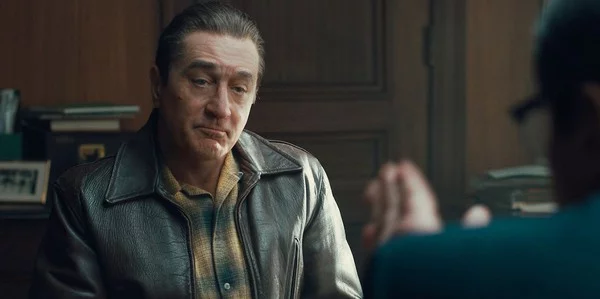
Though he’s surely trying his best to look like Travis!
Pacino as Jimmy Hoffa delivers Loud Al at his finest high-pitch peak not seen since he yelled “Great ass!” in HEAT—bottom line, this time it just works. And Pesci, well, he pleasurably does Pesci, albeit with half a sedative so that he’d rather tell somebody else in omerta code to beat the shit out of Billy Bats rather than impulsively do it himself. Keitel is also good in the film when he chooses to appear, but I couldn’t help but feel he had more that was left on the cutting room floor (hard, I know, to say about such a long film as it is). But to have them all in one opus—well, it’s The Agnolotti Avengers! Not to mention in a film that’s actually great! It’s a feat that gives Netflix its best possible populist chance to actually win Best Picture (and let’s be honest, even though ROMA was actually the best film of last year, a black-and-white subtitled movie was never going to win both Foreign and Picture). If Netflix doesn’t win with THE IRISHMAN, it never will.
And speaking of Netflix, despite the fact that the film works as a cohesive whole that serves up the fastest moving three-and-a-half hours imaginable (faster than most two-hour movies, and shockingly not in need of any intermission, despite being only seven minutes shorter than LAWRENCE OF ARABIA), the structure surprisingly lends itself to four distinct, episodic sections I will describe as thus in a purely syntactic way:
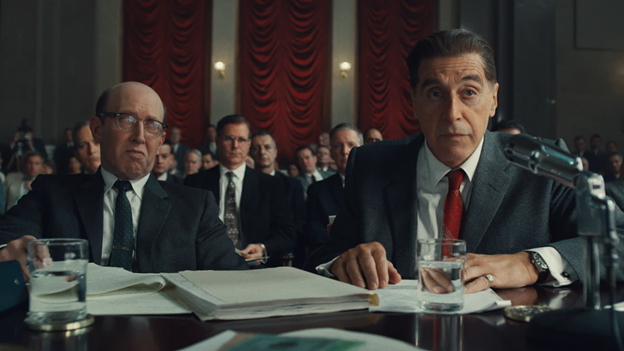
Pictured: Every critic taking notes throughout the monolith
Part I: Kind of like GOODFELLAS? Except if GOODFELLAS itself might be considered the cinematic equivalent of the energetic studio version of Eric Clapton’s “Layla,” then this first part of THE IRISHMAN, complete with its inside-baseball voiceover, mob-scamming antics, and colorful characters, might be considered to be the slower, more mature acoustic version of Clapton’s evergreen. Like my favorite restaurant on Arthur Avenue in The Bronx—Mario’s, whose burnished red walls complement a brown anchovy sauce-doused dish of Spiedini—this section serves a familiar, nostalgic appetizer to the main course of the film, albeit with a fishy whiff of mature elegy that foreshadows the somber tone to come.
Part II: The Miniseries Section! The next hour-and-a-half or so (I wasn’t wearing a watch, so this is honestly a rough guess) that begins when Hoffa gets on the phone (as we’ve seen in the trailer), and ends in a subtle dance of death slightly reminiscent of “I knew it was you, Fredo.” This part of the film tracks major historical events that tend to make their way into many a ‘60s period piece (the Bay of Pigs, JFK’s assassination, and even Crazy Joe Gallo’s assassination at Umberto’s Clam House in Little Italy). Naturally, these incidents are filtered through the eyes of our protagonists. And along the way, we are afforded the time (itself its own feature-length segment) to really understand the depth of the relationship that developed between Sheeran and Hoffa. A depth rarely afforded outside of a television series, mind you, and a depth that becomes all the more heartbreaking when that relationship comes to a head. This is the meat of the film—the Chicken Scarpiello with succulent sausage freshly pinched that you might find at Mario’s. But, despite all the great flavors and finesse that came before—I would be lying if I didn’t think the final two parts that comprise the final hour or so are the most fascinating (as this is a film that truly gets better as it goes along):
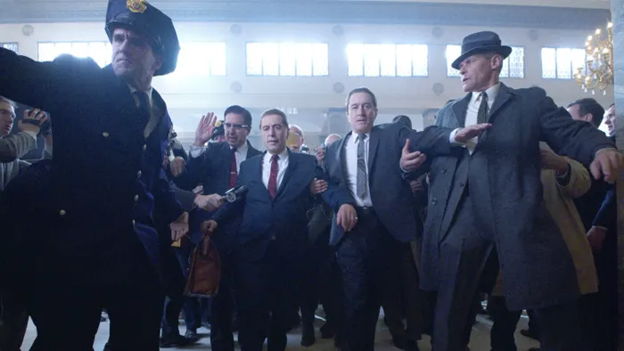
Pictured: me running out of the theater to write this review
Part III: When Everything Goes Robert Bresson. Very austere. Very. Austere. Complete with elemental shots reminiscent of Melville’s LE SAMOURAI or Bresson’s own A MAN ESCAPED. Pans from right to left as characters silently walk off planes, enter cars, silently stare with deathly glares as another character talks about fish with utterly grim banality. A section that centers around the motif of the same repeating still composition of the same suburban electrical pole that we drive past over and over again as we build and build towards… (well, if you know your mob history, I think you can guess what it is). And indeed, when we reach the ultimate climax of this segment (the explosion of the proverbial bomb under the table), which comes about a half-an-hour later, it is shown with a Son of Saul-esque whisper (a whisper tinged with a vermouth-in-a-martini-sized regret). Not with a bang. Crimson red production design (the door, the car, the shirt) are all the blood we need to see, and yet we yelp nonetheless because we have been met with only serious silence for such a long time before that bang. This is the simple, yet aesthetically perfect pizza you can only order off the menu at Mario’s. Cheese. Sauce. Crust. That’s it. Enough said.
Part IV (Epilogue): The Heart of THE IRISHMAN. The espresso with anisette drank as an aperitif. In which Scorsese extends a denouement from three minutes to over 30 minutes (something he previously attempted to a conversely deadening effect in the otherwise fun and flashy WOLF OF WALL STREET). An epilogue not only to this film, but to every mafia film he’s ever made. No de-aging necessary, and not a spoiler to say that De Niro makes it to old age, as he remains the last one standing (or sitting) from the very first shot of the film telling his story. He takes stock of the consequences that are the result of his life choices that the previous three hours have laid out in novelistic detail. Where we finally see that you reap what you sow. It also doesn’t hurt that there is a knee-slappingly hilarious and unexpected cameo from Action Bronson thrown in that’s just morbidly perfect. Nonetheless, it is this segment of the film that could only exist within the syntax of a three-and-a-half-hour structure. Where all other films would only have three minutes to perfunctorily say the same thing, we are here given a long, haunting portrait of what it means to grow old.
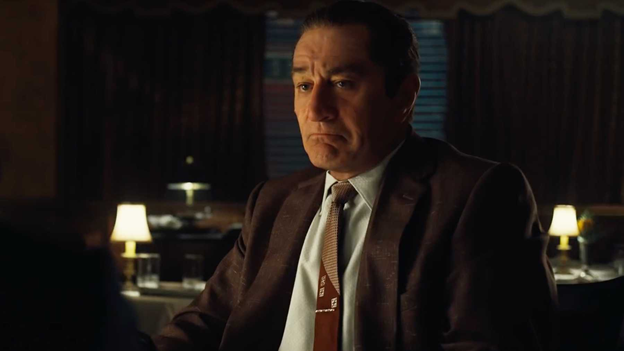
Proof that if you hold that frown for long enough…
And now that we’ve established that this is a phenomenal film you will no doubt love if you at all appreciate great cinema—let’s get to the question on everybody’s mind: how’s the de-aging? The central CGI trick upon which the existence of this film is predicated. Honestly, it’s objectively not very good. On a scene-by-scene basis, it does not pass muster. Because its flaws will grow more apparent when you are indeed watching this on Netflix, and the suspension of disbelief created by the sustained black box of a movie theater is broken every time you want to microwave a Hot Pocket at home. At its worst (in the 1950s/1960s scenes, to say nothing of the mercifully brief WWII flashback straight out of Call of Duty), it can feel like you’re watching character renderings of De Niro or Pacino in one of the cash-in Godfather or Scarface games. By the time you get to the characters in the 1970s-set scenes, it’s perfectly fine (getting the characters to their mid-50s, I guess, is about as low as you can convincingly go). But you’ll smirk when Pesci—whose odd facial features actually allow him to come out looking the best (read: least distracting) when de-aged—refers to De Niro as a “young kid.”
But enough nitpicking. In fact, a subtle, unintentional blessing that came from the expensive de-aging process was the fact that Scorsese had to shoot the majority of the film’s scenes with a cumbersome three-camera rig that couldn’t help but restrict him from indulging in too many crazy shots. In fact (while this film does still sport some impressive flexing shots that fly through courtrooms and dolly through nursing homes), this is a film of two shots: shot and reverse-shot. That might sound boring. It’s not. It’s pure cinematic confidence. And as we watch scene after scene of characters talking conspiratorially to one another, we are given a full Italian mafia meal worthy of Mario’s. All of this is to say: Watch this thing in a theater! By all means I’m happy that this will live for many Thanksgivings on Netflix alongside Godfather marathons—but the first time you see it (because you will see it multiple times, I’m sure), please just make the effort to get off the couch and allow this to be the out-of-the-house event it deserves to be.
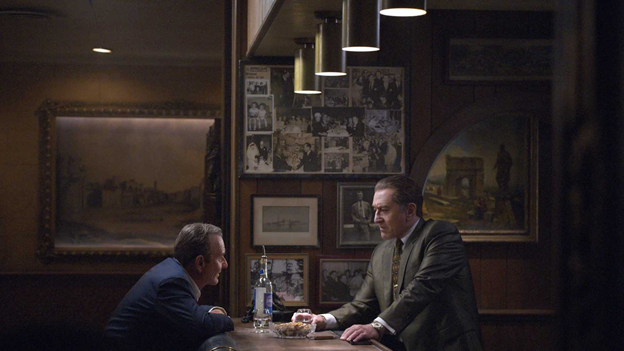
My dad and I discussing the movie over drinks afterwards
Finally, the deceptively intimate visual style culminates in a heartbreakingly lonely shot made even more poignant by its blatant homage to the last shot of John Ford’s THE SEARCHERS. This is a reference that shouldn’t be minimized, as that is one of Marty’s favorite films, and is something that Harvey Keitel’s character extensively talks about in the opening scene of Marty’s first movie, WHO’S THAT KNOCKING AT MY DOOR, which upon thinking about it, provides further proof that perhaps this really should be his final film. I mean, wow, what a perfect bookend. At the very least, it will probably be Scorsese’s final gangster film, made with the men who defined the genre. And as I looked over at my father, bearing his white mane of hair unfortunately not too dissimilar to the one on De Niro’s head, I couldn’t help but feel a twinge of melancholy that this was the last time we would ever experience a new gangster classic together, at least in the way we knew them. But what an ending—to a life; to a film; to a career; to an era of discovering the magic of gangster movies with my father.



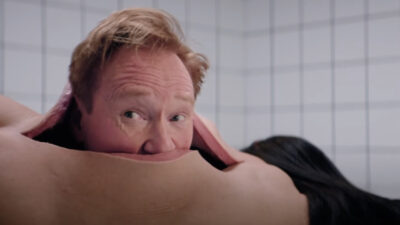












Dear Reid,
I loved the comparison between different sections of the film and the meal at one of your favorite (probably) ‘mob approved’ restaurants. Seems you are a foodie too. I cherish the rare moments when I get to watch or play content, which is a remake of, or very similar to that which I enjoyed during childhood.
Dear Reid,
I loved the comparison between different sections of the film and the meal at one of your favorite (probably) ‘mob approved’ restaurants. I cherish the rare moments when I get to watch or play content which is a remake of, or very similar to, that which I enjoyed as part of my childhood.